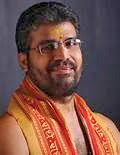The Process of Yoga 2.2: Swami Krishnananda.
==============================================================
============================================================
Saturday, February 12, 2022. 06:00.
Chapter 2: The Structure of the Universe-2.
===============================================================
What is the outcome of this analysis? We know that the five elements – or the world, for the matter of that – exists, not because of the status that the world itself occupies but because its status is recognised by some other principle which cannot be included within the category of objects. If no one is to know the world, there is no saying whether the world exists or does not exist. The existence of an object – let it be a large object like the world – is dependent on a consciousness of the object. When we are not aware of anything, we can say that such a thing does not exist. We have no proof for the existence of super-elemental principles, and therefore we go scot-free from laws that seem to be operating beyond the objects of sense.
Thus, when we have the world of objects on one side, we seem to have another series of facts on the other side which cannot be gainsaid and whose presence has to be accepted automatically together with the acceptance of the existence of the world of objects. If the world exists, a seer of the world also exists. If a seer of the world were not to exist, the world also need not exist. As they say, the proof of the pudding is the eating thereof.
The existence of the object seems to be in some respect identical with its capacity to be perceived. There was at least one great thinker who boldly proclaimed that to exist is to be perceived. In the West a representative of this school is Bishop Berkeley; and in the East the representatives are known as the Vijnanavadin Buddhists. To exist is to be perceived. If something is not perceived, it does not exist.
Now, perception does not mean merely coming before the organ of sight. Perception means the capacity to come within the cognition of any of the five senses, whether it is sight, hearing, taste, tangibility, or coming within the purview of the olfactory sense. Wonderful is this conclusion that to exist is to be perceived! So if I do not perceive you, you do not exist. This was a very startling and shocking conclusion to the world of philosophers. How can you say that I do not exist merely because you do not see me?
This was a deathblow given to the traditional schools of thought that were parading their knowledge before the birth of Berkeley in the West and before the birth of the Vijnanavadin Buddhists in the East. I can exist even if you do not see me. Then why should not anything exist even if we do not see it? This was another conclusion that could be drawn from this reaction to the school of thought which concluded that the essence of existence is perception. If I can exist even if nobody sees me, why should not anything else exist if nobody sees it? And if your conclusion is that something cannot be accepted as existent unless it is seen, well, I can say that you also do not exist if I close my eyes.
To be continued ....
================================================================






Comments